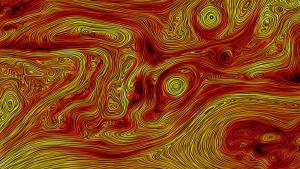Blog
Eddies in the
Space-Time Continuum
7 June 2014
 Burlen Loring, Berkeley Lab
Burlen Loring, Berkeley LabWe often refer to gravity as a gravitational field because it can be described mathematically as a field. That is, each each point in space and time has certain characteristics, and they are related to each other through field equations. For gravity, the field equations are the equations of general relativity. Lots of physical quantities can be described as fields, including electromagnetism and quantum objects. Fluids are also described mathematically as fields. With a flow of water or air, for example, every point has properties such as pressure and speed, and they are related by equations of fluid dynamics.
There are some similarities between these different types of fields. Just as you can have waves in water or sound waves in air, you can have light waves in electromagnetism and gravitational waves in general relativity. But one thing that sets them apart is that water and air can experience turbulent motion, such as the swirls of smoke that rise from a campfire. Gravity doesn’t exhibit that kind of motion. Or at least that is what we’ve generally thought.
Now a new paper argues that gravity can exhibit turbulence.1 The paper hasn’t yet been peer reviewed, but it is an extension of work that has. The work is based upon a connection between gravity and fluids. Since gravity is a field, and fluids are fields, it is possible in some circumstances to treat gravity as a fluid (and fluids as a gravitational field). This is known as gravity-fluid duality, and it is related to the holographic principle where a region of space can be described by its boundary. This doesn’t mean that gravity is a fluid (as some popular science articles are claiming) simply that it can be described as one.
This gravity-fluid duality has been known for a while, but one of the difficulties has been that fluids experienced turbulence while gravity did not. Even computer simulations of strong-gravity interactions such as merging black holes haven’t shown any turbulence. There have been examples of turbulence in gravitational models, but they have been for non-physical cases such as anti-de Sitter space, or 2 + 1 gravity. Now this new paper uses the gravity-fluid duality to show that gravitational turbulence can occur in the vicinity of rapidly rotating black holes.
This is still theoretical, but the authors demonstrate that such gravitational turbulence would have a distinct signature within gravitational waves. If we become successful in gravitational wave astronomy, we will be able to detect the presence (or absence) of turbulence near a rotating black hole. Another consequence is that it further strengthens the theoretical connection between gravity and fluids. This means that fluid turbulence can also be modeled gravitationally. That may lead to new ways to deal with turbulence in fluid models, which can be particular problematic.
Again, this still needs to be peer reviewed, but it seems that black holes really can produce eddies in the space-time continuum.
Yang, Huan, Aaron Zimmerman, and Luis Lehner. “Turbulent black holes.” Physical Review Letters 114.8 (2015): 081101. ↩︎